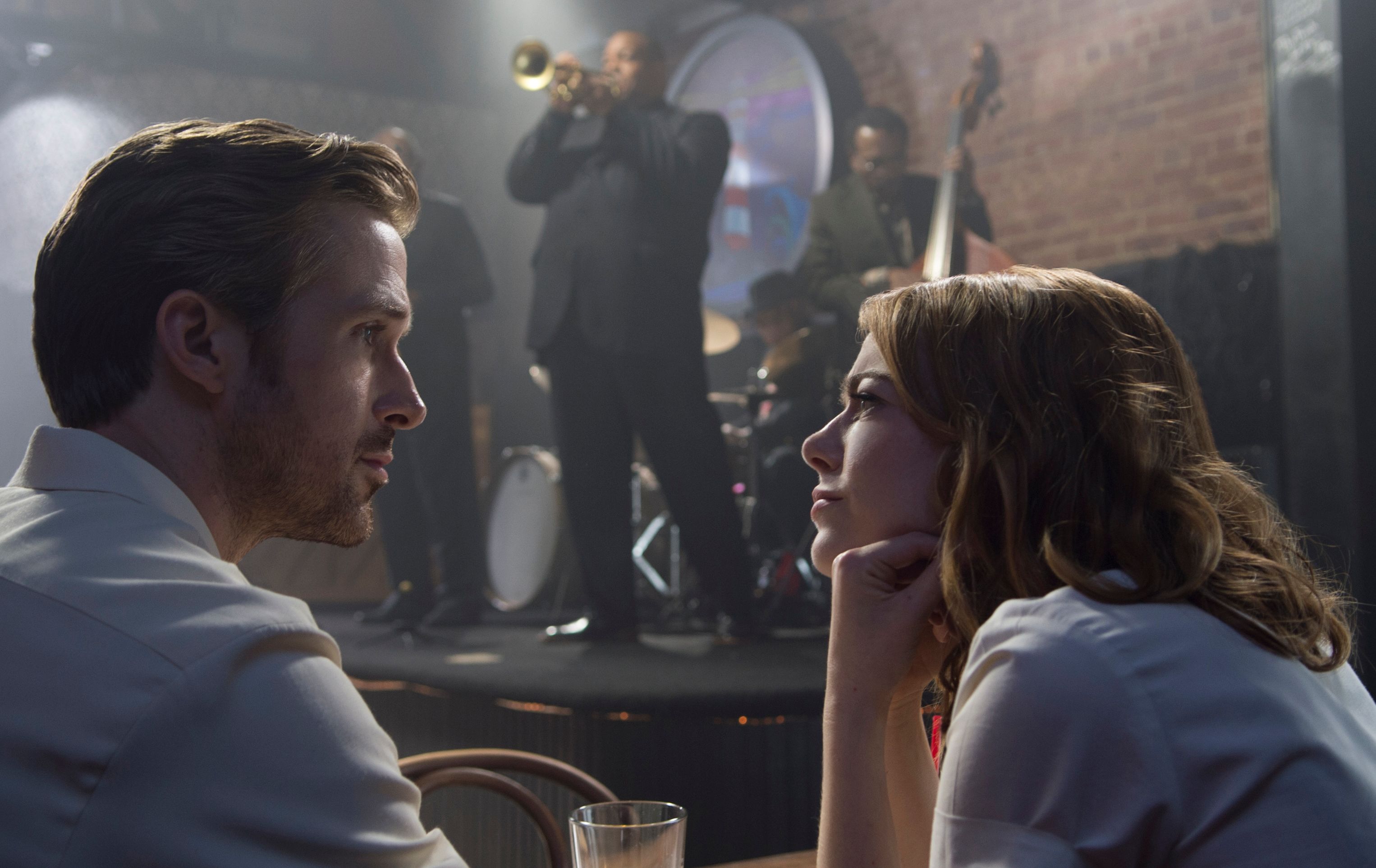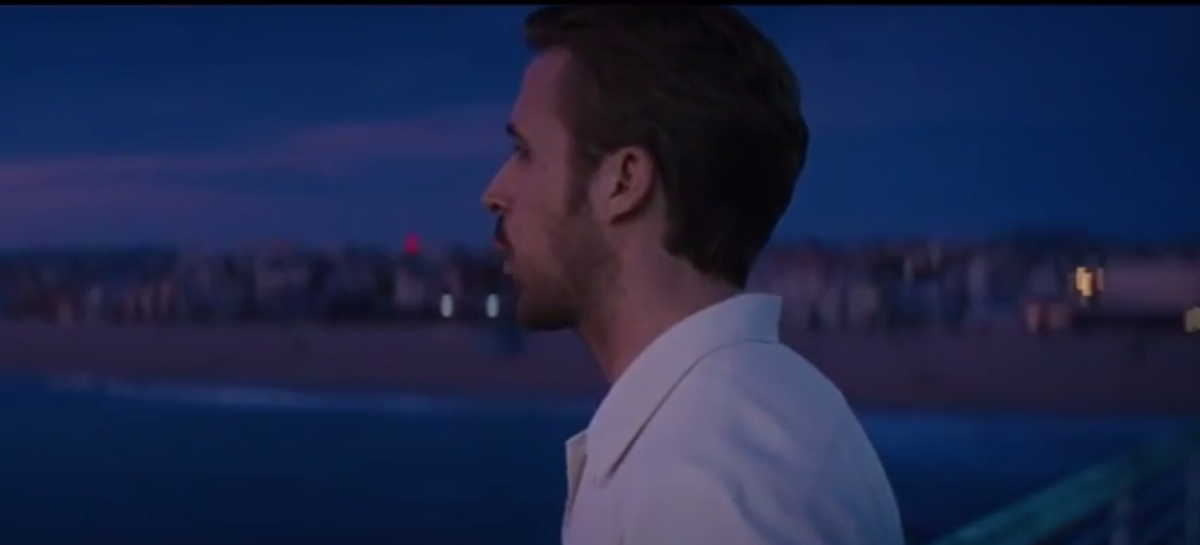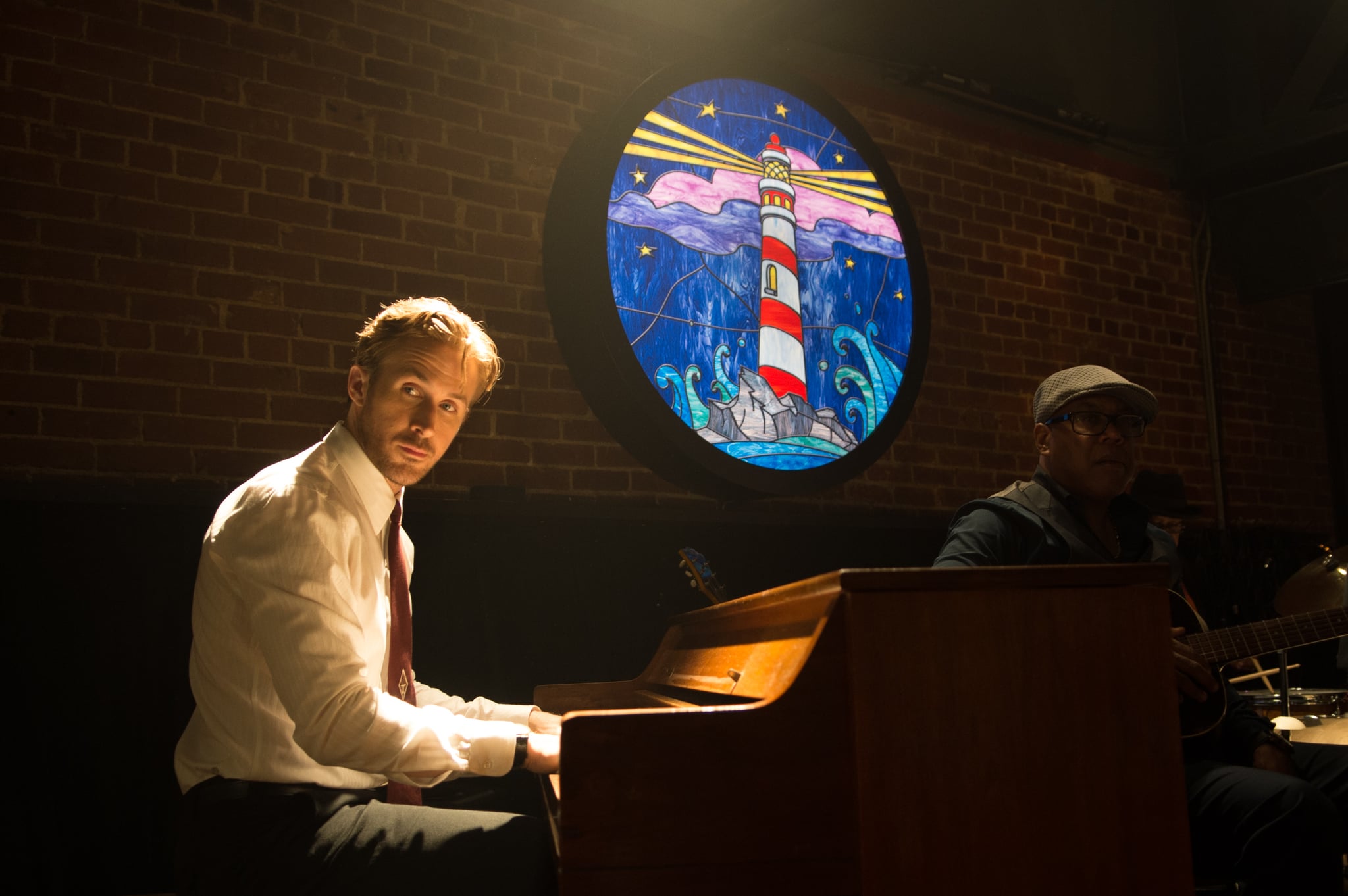There's a moment in Damien Chazelle's La La Land in which Sebastian Wilder (Ryan Gosling) strolls out along the Hermosa Pier by dusk and sings what may be the film's signature number, "City of Stars." The fact that the jazz purist Wilder shows up in Hermosa Beach, just as he and his struggling actress paramour Mia Dolan (Emma Stone) magically pop up all over the sprawling metropolis of Los Angeles, is a bit of geographic chicanery one will readily enough grant the filmmaker. This clearly is the stuff of fantasy. The film is called La La Land after all (significantly, it's also more of a tourist or media moniker than one a native Angelino or anyone who really understands and loves the city would tend to employ), and Mr. Chazelle would seem to feel that he's produced an homage, if not a scion to the Hollywood musicals of yesteryear.
What's interesting about the brief pier interval and the tune, carried on Mr. Gosling's limited and yet distinctive baritone, is that it hints at a depth and a darkness into which La La Land only rarely dangles its reluctant toes. As the song begins, it actually sounds like something the actor - and not the soundtrack's composer, Justin Hurwitz - might have composed for the film himself. Mr. Gosling, along with Zach Shields (and the Silverlake Conservatory Children's Choir, reminiscent of those eager young North London choristers who abetted Pink Floyd with "Another Brick in the Wall, Part 2") produced the self-titled Dead Man's Bones in 2009. The slightly haunting rise and fall of "City of Stars'" melody isn't so removed from the dark sonic carnival of Dead Man's Bones, but the music is by Mr. Hurwitz. The solid and reasonably nimble tunes (not so much the lyrics by Benj Pasek and Justin Paul) are about the only aspect of La La Land that lingers as one scene replaces the next, after the closing credits proceed.
 | |||||||||||||||||||||||||||||||||||||||||||
| Hey everybody, there's a sale at The Gap! Surprisingly happy commuters in Damien Chazelle's La La Land |
Mr. Chazelle does not lack for energy or exuberance. We're introduced to the film's charming leads, as well as group of very limber commuters at the outset, which is clearly supposed to be a great, colorful opening fanfare, announcing a big film with a bang. There is a bang but it turns out to be a resounding blank. What's most impressive about this scene, which involved two days of shooting on a closed-down section of the 105/110 interchange in Los Angeles, as with The Blues Brothers and their pursuers running amok in Chicago, is the degree to which the film production is able to have its way with the traffic of a major city. Not so much the forgettable if energetic action we get on screen.
Before all of the stranded and very colorfully-clad commuters exit their vehicles and begin to dance, car surf and even skateboard with abandon, there is a proud, throwback announcement that what we're about to see will be presented in Cinemascope. A grand old tool it is, but you have to know how to wield it, how to fill that broad frame. There are stills from the two days of shooting (especially one with bodies aloft above cars and seemingly the vast city) that hint at the potential. Very little that happens in the real time of the scene registers in any memorable way. Mainly, it's a kind of happy, multi-cultural throwdown, the mere premise of which is supposed to thrill.
Elsewhere, Chazelle does better with foreground dancing and singing against the almost infinite Los Angeles basin backdrop. There are judicious long takes of Emma Stone and Ryan Gosling doing their own dancing and singing, demonstrating a real chemistry, a pleasure at what they're doing and with each other. The limitations of the two leads with regard to the songs or fancy steps (particularly the often thin voice of Ms. Stone when it is plaintively on the verge of breaking) is actually a strength, something quite real amid all the make believe.
Elsewhere, and too often, Damien Chazelle continues to be a director without a strong sense of how to direct. This is true of relative throw-away moments as when we get intense point of view closeups of coffee making (Mia is a barista on what is supposed to be the Warner Brothers lot). We certainly are made aware that coffee is being made, but in La La Land, these are only empty gimmicks, rote 21st-century flourishes. Compare these moments to those of a far more original director, Edgar Wright. When the lads in The World's End (2013) queue up at one of bars along their epic pub crawl, we get seemingly similar shots of lager whooshing into glasses. But there, the procession of pints actually tells us something about the ill-advised single-mindedness of the endeavor, the excess. And there's even wit, as when flow of beer gives way to a prim stream of water for the teetotaler of the group. There's a sense that the director has actually thought about what he's doing. There's a point.
More significant than the capturing of coffee making, there is the filming of musical performance. For a man whose films scream, "I love jazz!," Damien Chazelle demonstrates no ability to film it with any style or insight. There's yet more of the herky-jerk, over-stimulated spectator at a tennis match point of view that so plagued Whiplash (2014). Fortunately, there's less of this manic camera swiveling in La La Land, but Chazelle's two directorial settings seem to be swing wildly or stare intently. Neither give us much feeling for the music in the apparent spotlight.
Whether the perspective is broad or close, the direction of Mr. Chazelle's first three features is rife with borrowed gestures, misdirected energy and little that resonates longer than a firework in the night sky.
What is true of direction also, alas, applies to script: nuance is clearly not a defining characteristic of Damien Chazelle's work.
There's more pontificating here about jazz purity, more nuggets of supposed jazz history offered up by the pianist Wilder. But before you swallow those morsels whole, be aware that the anecdote of which Chazelle and his characters made such hay in Whiplash - Charlie Parker nearly being decapitated by a cymbal thrown by drummer Jo Jones because his playing that wasn't up to snuff - was largely fabricated.
The view jazz we get in Mr. Chazelle's last two films, beyond their dubious presentation, is largely conservative and reductive. A crowd-pleasing enough proclivity, but hardly doing justice to an art form the director references and exploits to such lengths. There's a conversation between Wilder and a musical colleague, Keith (John Legend), in which the latter tells Wilder he's too much of a traditionalist, that jazz has stayed vital precisely because the greats broke with tradition. It's a good point, but offered by a character who we eventually see involving the keyboardist in a kind of carnival of musical schmaltz, with several watered-down genres at play, complete with superfluous dancers. An exacting discourse on the definition and progression of the genre is hardly required in such a piece of entertainment. But if Mr. Chazelle wants to keep expounding on the sanctity and definition of jazz, he should probably demonstrate a less superficial understanding of the art form.
 |
| Please, tell me more about this jazz music. Ryan Gosling and Emma Stone in La La Land |
Fortunately, the handsome and affable chagrin that is Ryan Gosling is not always taken up with these jazz-lite lectures. Despite the actor's somewhat mask-like good looks, something in the frequently waning gibbous of those ever-gleaming blue eyes has always been able to suggest hurt, disquiet, melancholy (never more so than in excellent Half Nelson (2006). The sun might be shining bright, but you get sense the clouds are never far away. All of which abets Gosling's (and Sebastian Wilder's) easy charm and adds at least a little needed depth the character as drawn sorely lacks. Already a musician, Gosling practiced for hour each day to be able to perform the demanding keyboard runs required of him in La La Land. Because, you know the jazz - it's fast, fast, fast, man! Go daddy-o! Uh, yeah.
Chazelle does well with his leads and he certainly can't go too wrong as long as his camera is trained on Emma Stone. Ms. Stone's performances have sometimes swung with the quality of her roles and films. There were early and strong indications of her particular charm in Superbad (2007) and Zombieland (2009). Served one of those sophisticated decades beyond her teen years roles in Easy A (2010), she handled it with zest and intelligence. In Birdman (2014), we found out she can hit pretty hard if given the weight with which to swing. With the lesser gravity of Mia Dolan in La La Land - why, the poor woman and her equally buoyant fella positively float into the night sky of the Griffith Park Observatory! - Emma Stone makes you wonder what a pleasure it might well be to observe her mature on screen.
La La Land is obviously a film for which place looms large. If one were given to such flourishes, one might even say that Los Angeles is something of a character in the film. Alas, it's not a character whose remarkable complexity and breadth La La Land begins to suggest. If your knowledge of the city was confined to images of Hollywood Boulevard, Rodeo Drive and maybe some grand old joint like the Grauman's Chinese Theater, the film's use of locations like Griffith Park Observatory, the Watts Tower and the Colorado Street Bridge in Pasadena might give you the idea you've gotten around the city a good bit. True enough, but only in the most narrow sense.
For a film that seems to want, among other things, to be about a place, there's just no hint of the darkness, as well as the teeming vitality, diversity (something at which La La Land makes conspicuous but fairly shallow stabs), even joy, that makes Los Angeles the extraordinary place it is. Even if you don't care to explore the desert darkness which has always been a part of the city ( and much as your time would be vastly better spent watching David Lynch's Mulholland Drive (2001) or Inland Empire (2006), reading Joan Didion's dispatches from and about the place), a film like last year's wonderful, even feel-good documentary City of Gold, about the food writer Jonathan Gold, will tell you more about the elusive metropolis than a hundred such films as La La Land.
 |
| Tourist time in La La Land: The Angel's Flight funicular, Colorado Street Bridge and Griffith Park Observatory |
Mr. Chazelle is apparently a fan of the great Jacques Demy. This is evident in the film's color and exuberance, particularly that first freeway scene. Demy's wonderful musicals - The Les Parapluies de Cherbourg (The Umbrella's of Cherbourg, 1964) and Les Demoiselles de Rochefort (The Young Girls of Rochefort, 1967) most well-known among them - draw rather nakedly on Hollywood Golden Age musicals and jazz, among many other influences. And yet, for all the goofy jazz of "Young Girls, " for all the nearly laughable lyrics, for the intensely colorful near-opera that is "Umbrellas," there is something that connects, something that lingers. Something which La La Land tends to la la lack. With Mr. Chazelle there is simply a lot of sound and fantasia which signify nothing. One can't but help wonder if all the critics gushing about La La Land will remember a thing about the film in a year's time, in six moths.
 |
| The Young Girls of Rochefort (1967) |
For all their brightness, their seeming innocence, Demy's most famous musicals are all the more affecting for the emotional undertow, the darkness or melancholy chasing those characters (especially in "Umbrellas"). The director also made musicals that touch upon decidedly un-Hollywood subjects like labor rights, even incest.
 |
| Model Shop (1969) |
Among Jacques Demy's non-musical films, there is the little seen Model Shop (1969). As he tended to do, Demy let a character from an earlier film (the main character from Lola (1960)) drift into another of his stories. But by the time we see Lola relocated to Los Angeles about a decade later, the relative optimism of the previous film is gone. There's actually a great, very brief scene in season seven of Mad Men in which we see Don Draper sitting alone in a movie theater, watching Model Shop. It's a fairly brilliant reference, not only of time and place, but one to a film whose mood of disenchantment is so consistent with the character watching it. Anyone who's watched Mad Men knows how seamlessly creator Matthew Weiner and his talented cast and crew combined seductive aesthetics with story lines that tended toward the dark side of American life. For his part, in his brief visit to Los Angeles (even if he did succumb to the cliche of his main character living adjacent to an oil derrick) Jacques Demy's glimpse of the city, 45-years-old though it may be, rings with more truth about the city and its main industry of make believe than La La Land.
La La Land does at least represent a kind of progress for Damien Chazelle - it's not a very bad film; it's just not very good. It's vastly better than the director's first dancing and singing affair, the execrable Guy and Madeline on a Park Bench (2009). Even with its fantasy and flights of fancy, La La Land is certainly less ridiculous than the director's 2014 Whiplash (your average Planet of the Apes film is a good deal less ridiculous than Whiplash). One has to assume that all of these expressions of love, however uninspired - for singing, dancing and especially for jazz - are sincere. Unfortunately, all that love smacks of the mile wide and inch deep variety. Perhaps, to adapt the words of another jazz aficionado and shoveler of cheese, if you love something, you should set it free?
If La La Land leads a few people to watch or watch again The Umbrellas of Cherbourg or The Young Girls of Rochefort, it will have done some good. Check out those Demy films if you haven't yet had the pleasure. And while we (culturally) are supposedly discussing the best films of 2016, it seems quite criminal that we speak of the likes of La La Land and nary a word is being uttered about a film like Yorgos Lanthimos' The Lobster. The Lobster's deadpan style, muted colors and lack of resolution might seem like so many teaspoons of castor oil compared to La La Land's veritable box of sweets. But with it's audacious plotting, it's wit and the feat of making a film in the 21st century about our unquenchable yearning for love that is bracingly original, The Lobster soars, for film and audience alike, even as its character remain decidedly earthbound.
db







Comments
Post a Comment